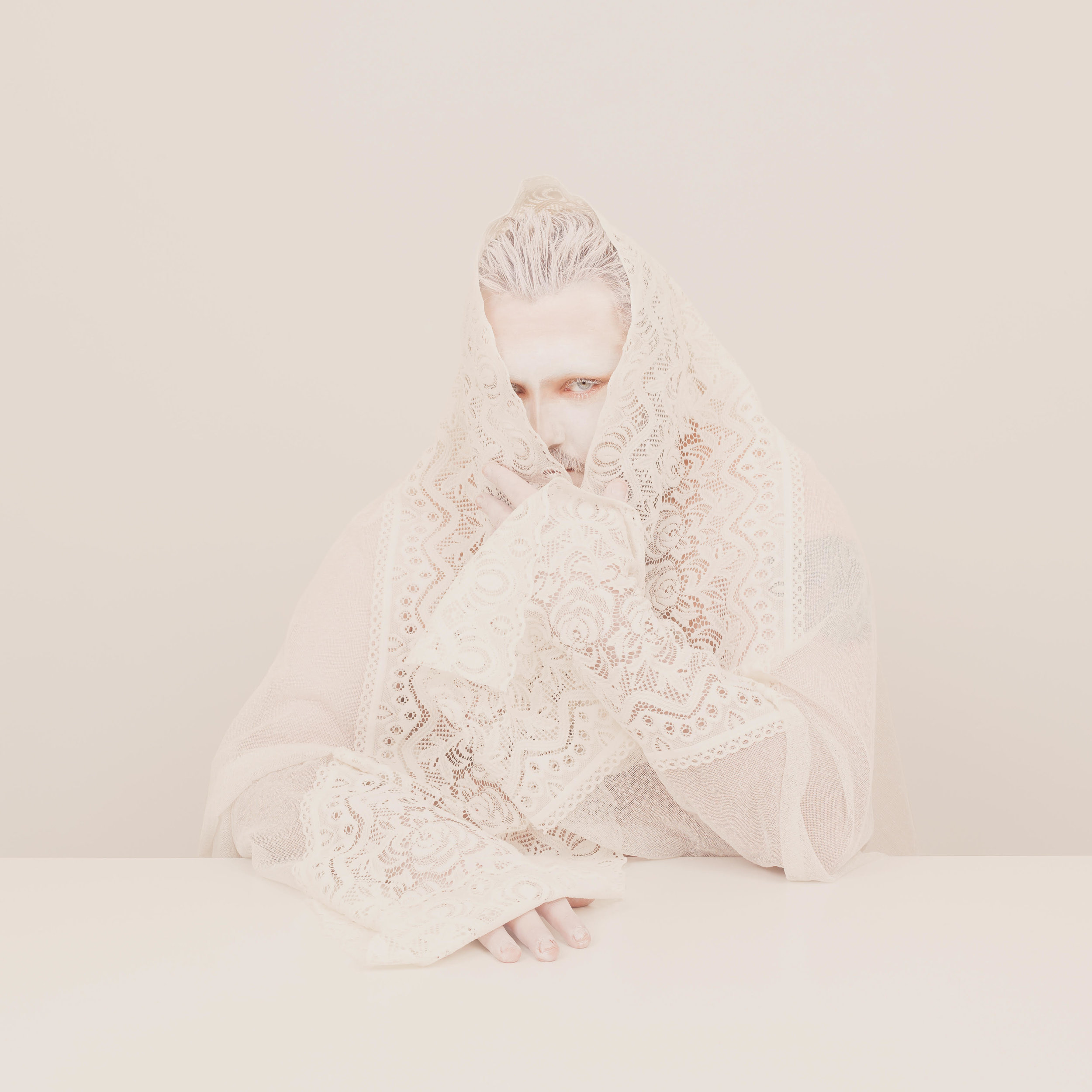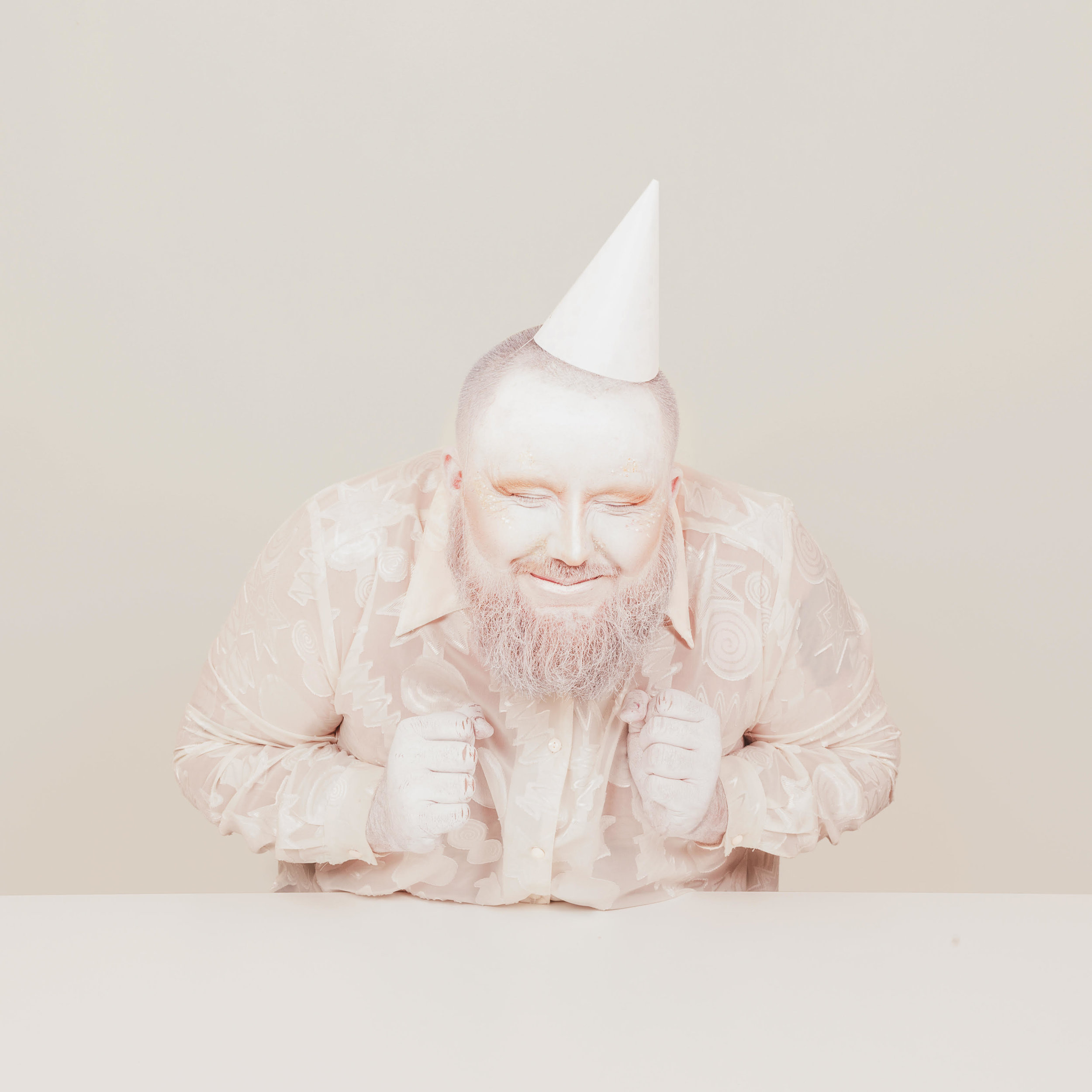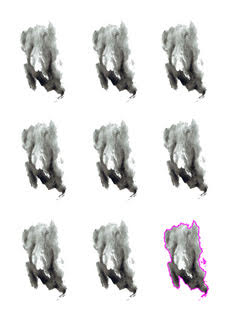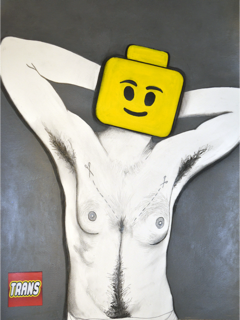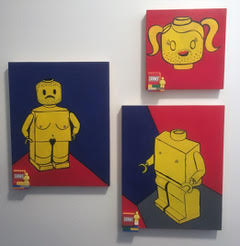Shelley Horan Sin at Cage me a Peacock Gallery, 22 September- 7 October 2017
By Charlotte St Clair Wilson, Director, Cage me a Peacock
“Sin” is Shelley Horan’s first solo exhibition. It is a series of seven staged portraits that explore human frailty. The images feature desperate and painful figures, rendered with a subtle pastel hue that belies their disquieting content. Embodied by performance artist Wade Tuck, the portraits have a theatricality reminiscent of Grand Guignol absurdism. The traditional iconography of the seven deadly sins serves as a backdrop, but they are not direct representations of these vices. Rather, they remain untitled, leaving it to the viewer to determine what sin, if any, exists in the work. The photographs are ambiguous, acerbic and almost menacing. Anguished behind a delicate veil or as a laughing clown, the subject is equally forceful. The subtlety of the palette adds to this air of menace – both internal and external. It doesn’t allow the viewer to get away with easy, dogmatic (or religious) concepts of sin – sin is fluid and subjective, sin is internalised and externalised, male and female. Horan presents these dichotomies but does not resolve them.
Horan’s pictures are camp and theatrical yet they retain an intimacy. They are as if a dramatic scene has been frozen in a single moment; a portrait snapped in the middle of an undisclosed and undefined drama. Performance in this setting is distancing device. These are intimate portraits but we know not of whom. Much like the best of theatre, they allow space for the viewer to interpret and transpose meaning. The soft pastel tone in this context both comforts and disturbs. When an ice blue eye stares out at us from behind a veil, a subtle variation in the colour, it simultaneously draws us into the soft lit world, tempts and lures us, yet frightens with its intensity. Horan plays on theatrical tropes and stereotypes – the bored, smoking housewife or the Shakespearean prince. The stage make-up covered beard, the wigs and props are absurdist, over-the-top in their campness, yet the threat in those eyes and the underlying darkness of each pose is stark. Stripped of movement and stuck within the frame, the threat of the “sin” (whatever it may be) is contained and left simmering beneath the soft surface. The viewer is left unsure whether we are complicit in, or voyeurs of the perpetrated sin. Horan presents sin as both personal and removed, both angry and absurd. She offers no easy readings and leaves the viewers deeply unsettled.
Shelley Horan is a photographer and artist originally from Queensland now living working in Melbourne, Australia. She has a BA (Hons) in photography from RMIT University. Horan works across photographic mediums to find intimate and revealing moments. She balances a love of theatre with the intimacy of portraiture. Sin is Horan’s first solo exhibition having previously shown in group exhibitions including Art Town (Chapel off Chapel), (UN) Natural (First Site), Shoot V2 (Melbourne Art Club), Contain Yourself (Henley Club) and the Undercoat Seasonal Collection (No Vacancy).
Ethan Kristy Man Cunt at Cage me a Peacock Gallery, August 2017
By Charlotte St Clair Wilson, Director, Cage me a Peacock
Cage me a Peacock is delighted to present Man Cunt, Ethan Kristy’s first solo show. Ethan's
work is confronting, profane and peppered with dark humour. It deliberately challenges the
viewer and forces a broad conversation about gender and sexuality. Yet it is also a deeply
personal account, Ethan uses their own body and their own transition journey as the focal
point for this discussion.
The transition narrative challenges conventional views of gender and sexuality by positing
these notions in the transitional and liminal - in Ethan's work, this is the "man cunt". Poverty,
violence, discrimination and mental health issues still disproportionately affect the trans
community. The trans body therefore sits as a site of violence. In the Inkblots series, Ethan
abstracts the body/genitals, stripping out its image through a process of casting, printing and
digitising. The result is a reclaimed artefact of the man cunt, an image that can be
commodified and duplicated. In calling the series Inkblot Ethan presents the viewer with a
Rorschach test - what is it that we see in the cast of genitals? Has the body been stripped of
its meaning and become merely Warholian pop repetition, or is it still the highly contested
site, albeit placed out of context? In asking these questions of the viewer, Ethan confronts
the notion of identity through gender, or identity in the corporeal. He is representing a central
idea in Queer Theory which says there is no fundamental self, gender is not an essentialist
concept. Rather, it is a contestable space.
Ethan's Trans Lego series asks a similar question of pop culture. It rebrands the trans body
into the recognisable Lego form. If the genital-less Lego bodies are given genitals does this
change their gender? Why does the gender of Lego matter if you can swap their hair and they
look the same? Why do these toys need to ascribe to a gender norm at all? By evoking
childhood toys, Ethan invites us to consider the difficulty of gender non-conformity in a
society that forces us into binary genders from the moment our birth certificates are issued.
In the Lego-face series (’Transgender’ Word of the Year) Ethan also pokes fun at the
sexualisation of the trans-community. The bodies are rendered silly and unimportant by the
vacantly smiling Lego head. But beneath this humour remains the dark reality of the
experience of the trans community - everything is not awesome.
Ethan's photographic works (Governance) depict the heads of gender and sexually diverse
people in various forms of imprisonment - from a cage to a gas mask. It is as if they are
trapped inside the depictions of their bodies, their identities constricted and obscured. They
are voiceless, faceless and nameless. Thus Ethan exposes the sexualised narrative of
transgenderism, gender and sexual diversity through cis eyes - a narrative that traps people
in a depiction of themselves purely through their genitalia. The person is treated like a
spectacle - a side show - rather than a person. These works depict the body as a highly
politicised site, a body that is the subject of surveillance and policing by others.
Thus Ethan’s show presents the viewer with a series of unanswered questions about gender
and sexuality. They are at once confronting and beguiling. Ethan presents the issues facing
trans and gender diverse people without sermonising. The beauty and humour of the work
juxtaposes with the darker exploration of marginalisation and fetishisation. It is the start of a
long and important conversation…
Ethan Kristy is a visual artist from Melbourne, Australia. Ethan works in mixed media with a
primary focus on themes of sexuality, gender and (dis)ability. Ethan advocates for queer,
transgender and (dis)ability rights and is currently completing a BA of Fine Arts at RMIT
University.

